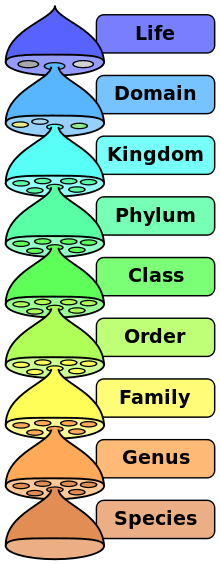Family (biology)

In biological classification, family (Latin: familia, plural familiae) is one of the eight major taxonomic ranks; it is classified between order and genus. A family may be divided into subfamilies, which are intermediate ranks above the rank of genus. In vernacular usage, a family may be named after one of its common members; for example, walnuts and hickory trees belong to the family Juglandaceae, commonly known as the walnut family.
What does or does not belong to a family—or whether a described family should be recognized at all—are proposed and determined by practicing taxonomists. There are no hard rules for describing or recognizing a family, or any taxa. Taxonomists often take different positions about descriptions of taxa, and there may be no broad consensus across the scientific community for some time. Some described taxa are accepted broadly and quickly, but others only rarely, if at all; the publishing of new data and opinion often enables adjustments and consensus over time.
Nomenclature
The naming of families is codified by various international codes.
- In fungal, algal, and botanical nomenclature, the family names of plants, fungi, and algae end with the suffix "-aceae", with the exception of a small number of historic but widely used names including Compositae and Gramineae.[1][2]
- In zoological nomenclature, the family names of animals end with the suffix "-idae".[3]
History
The taxonomic term familia was first used by French botanist Pierre Magnol in his Prodromus historiae generalis plantarum, in quo familiae plantarum per tabulas disponuntur (1689) where he called the seventy-six groups of plants he recognised in his tables families (familiae). The concept of rank at that time was not yet settled, and in the preface to the Prodromus Magnol spoke of uniting his families into larger genera, which is far from how the term is used today.
Carolus Linnaeus used the word familia in his Philosophia botanica (1751) to denote major groups of plants: trees, herbs, ferns, palms, and so on. He used this term only in the morphological section of the book, discussing the vegetative and generative organs of plants. Subsequently, in French botanical publications, from Michel Adanson's Familles naturelles des plantes (1763) and until the end of the 19th century, the word famille was used as a French equivalent of the Latin ordo (or ordo naturalis). In nineteenth-century works such as the Prodromus of Augustin Pyramus de Candolle and the Genera Plantarum of George Bentham and Joseph Dalton Hooker this word ordo was used for what now is given the rank of family.
In zoology, the family as a rank intermediate between order and genus was introduced by Pierre André Latreille in his Précis des caractères génériques des insectes, disposés dans un ordre naturel (1796). He used families (some of them were not named) in some but not in all his orders of "insects" (which then included all arthropods).
Uses
Families can be used for evolutionary, palaeontological and generic studies because they are more stable than lower taxonomic levels such as genera and species.[4][5]
See also
- Systematics, the study of the diversity of life
- Cladistics, the classification of organisms by their order of branching in an evolutionary tree
- Phylogenetics, the study of evolutionary relatedness among various groups of organisms
- Taxonomy
- Virus classification
- List of Anuran families
- List of Testudines families
- List of fish families
- List of families of spiders
Compare:
References
- ↑ Barnhart 1895.
- ↑ ICN 2012, Section 2. Names of families and subfamilies, tribes and subtribes Article 18.
- ↑ International Commission on Zoological Nomenclature (1999). "Article 29.2. Suffixes for family-group names". International Code of Zoological Nomenclature (Fourth ed.). International Trust for Zoological Nomenclature, XXIX. p. 306.
- ↑ Sarda Sahney, Michael J. Benton & Paul A. Ferry (2010). "Links between global taxonomic diversity, ecological diversity and the expansion of vertebrates on land" (PDF). Biology Letters. 6 (4): 544–547. doi:10.1098/rsbl.2009.1024. PMC 2936204
 . PMID 20106856.
. PMID 20106856. - ↑ Sarda Sahney & Michael J. Benton (2008). "Recovery from the most profound mass extinction of all time" (PDF). Proceedings of the Royal Society B: Biological Sciences. 275 (1636): 759–765. doi:10.1098/rspb.2007.1370. PMC 2596898
 . PMID 18198148.
. PMID 18198148.
Bibliography
- Barnhart, John Hendley (15 January 1895). "Family Nomenclature". Bulletin of the Torrey Botanical Club. 22 (1): 1–25. doi:10.2307/2485402. JSTOR 2485402.
- Bullock, A. A. (January 1958). "Indicis Nominum Familiarum Angiospermarum Prodromus". Taxon. 7 (1): 1–35. doi:10.2307/1216226. JSTOR 1216226.
- Bullock, A. A. (August 1958). "Indicis Nominum Familiarum Angiospermarum Prodromus: Additamenta et Corrigenda I". Taxon. 7 (6): 158–163. doi:10.2307/1217503. JSTOR 1217503.
- ICN (2012). "International Code of Nomenclature for algae, fungi, and plants". Bratislava: International Association for Plant Taxonomy. Retrieved 17 January 2016.